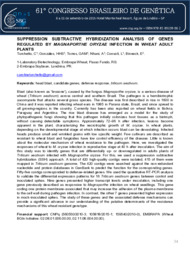Suppression subtractive hybridization analysis of genes regulated by Magnaporthe oryzae infection in wheat adult plants.
Suppression subtractive hybridization analysis of genes regulated by Magnaporthe oryzae infection in wheat adult plants.
Autoria: TURCHETTO, C.; GONZÁLES, H. H. S.; TORRES, G. A. M.; NHANI, A.; CONSOLI, L.; BINNECK, E.
Resumo: Blast (also known as brusone), caused by the fungus Magnaporthe oryzae, is a serious disease of wheat (Triticum aestivum) across central and southern Brazil. The pathogen is a hemibiotrophic ascomycete that attacks several grass species. The disease was first described in rice in 1600 in China and it was reported infecting wheat ears in 1985 in Paraná state, Brazil, and since spread to all growing-regions in the country. Currently has been also reported on wheat fields in Bolivia, Paraguay and Argentina. The rice blast disease has emerged as a model for the study of phytopathogenic fungi showing that this pathogen initially colonizes host tissues as a biotroph, without causing detectable symptoms. Approximately 72?96 h after infection, lesions become apparent in the plant, characterizing the necrotrophic growth of M. oryzae. In wheat plants, depending on the developmental stage at which infection occurs blast can be devastating. Infected heads produce small and wrinkled grains with low specific weight. Few cultivars are described as resistant to wheat blast and fungicides have low control efficiency of the disease. Little is known about the molecular mechanism of wheat resistance to the pathogen. Here, we investigated the responses of wheat to M. oryzae infection in reproductive stage at 40 h after inoculation. The aim of this study was to identify genes that are differentially up- or downregulated in adults plants of Triticum aestivum infected with Magnaporthe oryzae. For this, we used a suppression subtractive hybridization (SSH) approach. A total of 420 high-quality contigs were isolated, 415 of them were mapped in Triticum aestivum genome. The 420 contigs were searched against the non-redundant nucleotide and protein databases in GenBank to predict the function for the corresponding genes. Fifty-five contigs corresponded to defense-related genes. We used the quantitative RT-PCR analysis to validate the differential expression patterns for 16 Triticum aestivum genes between control and inoculated spikes. Nine genes presented higher transcript levels under inoculation, including one gene previously described as responsive to Magnaporthe infection on wheat seedlings. This gene coding one protein membrane-associated that may increase the adhesion of the plasma membrane to the cell wall during pathogen infection. In contrast, the other 7 genes presented higher expression in mock-inoculated spikes. The study of these genes and the associated defense mechanisms can provide a significant advance in our understanding of the putative determinants of the resistance mechanisms of this wheat resistant genotype.
Ano de publicação: 2015
Tipo de publicação: Separatas
Unidade: Embrapa Trigo
Palavras-chave: Trigo
Observações
1 - Por padrão são exibidas publicações dos últimos 20 anos. Para encontrar publicações mais antigas, configure o filtro ano de publicação, colocando o ano a partir do qual você deseja encontrar publicações. O filtro está na coluna da esquerda na busca acima.
2 - Para ler algumas publicações da Embrapa (apenas as que estão em formato ePub), é necessário ter, no celular ou computador, um desses softwares gratuitos. Sistemas Android: Google Play Livros; IOS: iBooks; Windows e Linux: software Calibre.
Acesse outras publicações
Acesse a Base de Dados da Pesquisa Agropecuária (BDPA) para consultar o acervo completo das bibliotecas da Embrapa.

